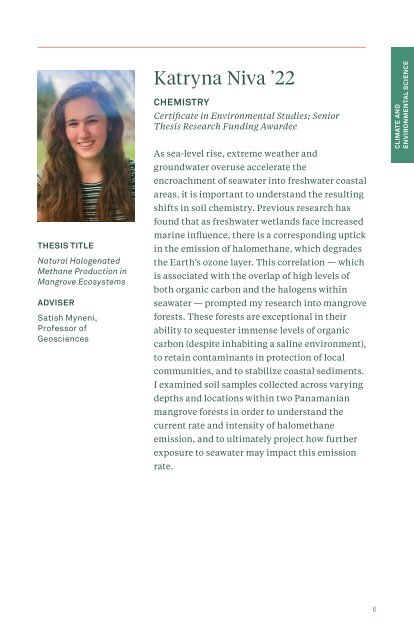Undergraduate Research: An Archive - 2022 Program
You also want an ePaper? Increase the reach of your titles
YUMPU automatically turns print PDFs into web optimized ePapers that Google loves.
THESIS TITLE<br />
Natural Halogenated<br />
Methane Production in<br />
Mangrove Ecosystems<br />
ADVISER<br />
Satish Myneni,<br />
Professor of<br />
Geosciences<br />
Katryna Niva ’22<br />
CHEMISTRY<br />
Certificate in Environmental Studies; Senior<br />
Thesis <strong>Research</strong> Funding Awardee<br />
As sea-level rise, extreme weather and<br />
groundwater overuse accelerate the<br />
encroachment of seawater into freshwater coastal<br />
areas, it is important to understand the resulting<br />
shifts in soil chemistry. Previous research has<br />
found that as freshwater wetlands face increased<br />
marine influence, there is a corresponding uptick<br />
in the emission of halomethane, which degrades<br />
the Earth’s ozone layer. This correlation — which<br />
is associated with the overlap of high levels of<br />
both organic carbon and the halogens within<br />
seawater — prompted my research into mangrove<br />
forests. These forests are exceptional in their<br />
ability to sequester immense levels of organic<br />
carbon (despite inhabiting a saline environment),<br />
to retain contaminants in protection of local<br />
communities, and to stabilize coastal sediments.<br />
I examined soil samples collected across varying<br />
depths and locations within two Panamanian<br />
mangrove forests in order to understand the<br />
current rate and intensity of halomethane<br />
emission, and to ultimately project how further<br />
exposure to seawater may impact this emission<br />
rate.<br />
CLIMATE AND<br />
ENVIRONMENTAL SCIENCE<br />
6
















